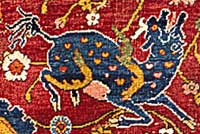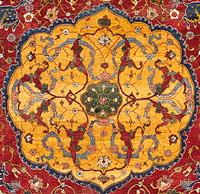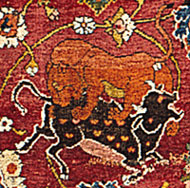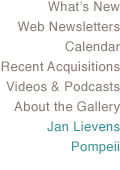
Selected Highlights | Artistic Exchange Brochure (PDF 260k) | Image List | Glossary
Introduction

![]() Great
collections of Western art such as the National Gallery's reflect
centuries of contact with the Muslim world and admiration for
Islamic art. While the European objects in the Gallery's permanent
collection were chosen for their own aesthetic qualities and
as exemplars of European culture, many reveal the broader international
context of their time. To complement the Palace and Mosque: Islamic
Art from the Victoria and Albert Museum exhibition (National Gallery of Art, July 18, 2004 - February 6, 2005),
we have identified objects throughout the West Building that
illustrate the rich and varied influence of the Islamic world
on European art.
Great
collections of Western art such as the National Gallery's reflect
centuries of contact with the Muslim world and admiration for
Islamic art. While the European objects in the Gallery's permanent
collection were chosen for their own aesthetic qualities and
as exemplars of European culture, many reveal the broader international
context of their time. To complement the Palace and Mosque: Islamic
Art from the Victoria and Albert Museum exhibition (National Gallery of Art, July 18, 2004 - February 6, 2005),
we have identified objects throughout the West Building that
illustrate the rich and varied influence of the Islamic world
on European art.

![]() During
the early Middle Ages, few Europeans ever saw art from Africa
and Asia--except for kings and emperors who received marvelous
objects as diplomatic gifts. The silk robes, huge tent, and live
elephant--named Abu'l Abbas--sent from Baghdad by Caliph Harun
al-Rashid to Emperor Charlemagne about 800, for example, became
the stuff of legend, celebrated in ninth-century annals and biographies.
More luxurious artifacts arrived during the eleventh century
as booty from military expeditions in Islamic Sicily, Spain,
and North Africa. The Crusades (1098-1291) brought Westerners
in direct contact with eastern Islamic lands. Crusader armies
and pilgrims to the Holy Land discovered a more refined civilization
and a richer material culture than they knew at home. Merchants
from Venice, Genoa, Pisa, Marseilles, and Barcelona shipped increasing
quantities of luxury manufactured goods--silks, inlaid metalwork,
painted glassware, and ceramics with the luster of gold--from
ports in Syria, Palestine, and Egypt. During the rule of the
Mongol khans (1256-1353) the whole of the Asian mainland from
Mesopotamia to China opened to European traders and travelers.
Despite religious and political differences and periodic wars,
Europeans maintained diplomatic and commercial relations with
Egypt and Syria from the 1340s, with the Ottoman
Empire from
the 1450s, and with Safavid Iran
from the early 1600s.
During
the early Middle Ages, few Europeans ever saw art from Africa
and Asia--except for kings and emperors who received marvelous
objects as diplomatic gifts. The silk robes, huge tent, and live
elephant--named Abu'l Abbas--sent from Baghdad by Caliph Harun
al-Rashid to Emperor Charlemagne about 800, for example, became
the stuff of legend, celebrated in ninth-century annals and biographies.
More luxurious artifacts arrived during the eleventh century
as booty from military expeditions in Islamic Sicily, Spain,
and North Africa. The Crusades (1098-1291) brought Westerners
in direct contact with eastern Islamic lands. Crusader armies
and pilgrims to the Holy Land discovered a more refined civilization
and a richer material culture than they knew at home. Merchants
from Venice, Genoa, Pisa, Marseilles, and Barcelona shipped increasing
quantities of luxury manufactured goods--silks, inlaid metalwork,
painted glassware, and ceramics with the luster of gold--from
ports in Syria, Palestine, and Egypt. During the rule of the
Mongol khans (1256-1353) the whole of the Asian mainland from
Mesopotamia to China opened to European traders and travelers.
Despite religious and political differences and periodic wars,
Europeans maintained diplomatic and commercial relations with
Egypt and Syria from the 1340s, with the Ottoman
Empire from
the 1450s, and with Safavid Iran
from the early 1600s.

![]() The Gallery's Late-Medieval and Renaissance-period collections reveal this European fascination with Islamic art--in depictions of the objects themselves and in the appropriation of Islamic designs. The portrait of an Italian cardinal makes ostentatious display of his fine Turkish carpet. The golden halo of a Florentine Madonna is patterned after a brass tray with an Arabic inscription from Syria or Egypt. Ceramics and metalwork made in Italy, France, and Germany were inspired not only by Islamic artistic forms and techniques but by Muslim customs as well.
The Gallery's Late-Medieval and Renaissance-period collections reveal this European fascination with Islamic art--in depictions of the objects themselves and in the appropriation of Islamic designs. The portrait of an Italian cardinal makes ostentatious display of his fine Turkish carpet. The golden halo of a Florentine Madonna is patterned after a brass tray with an Arabic inscription from Syria or Egypt. Ceramics and metalwork made in Italy, France, and Germany were inspired not only by Islamic artistic forms and techniques but by Muslim customs as well.
Nineteenth-century French paintings such as Renoir's Odalisque show new interest in the scenery, people, and culture of Egypt and of French-occupied North Africa, which were often highly romanticized. Increasing foreign travel in the nineteenth century encouraged the collection of old Islamic objects. One of the Gallery's founding donors, for example, shared the growing esteem for early oriental carpets and presented several fine ones to the Gallery. These are the only Islamic objects in the collection--but hardly the only appearance of Islamic art.
Selected Highlights | Artistic Exchange Brochure (PDF 260k) | Image List | Glossary


